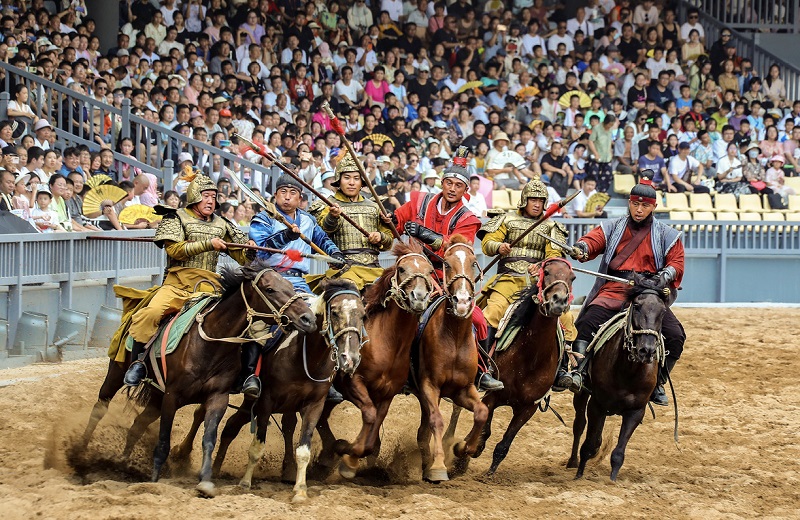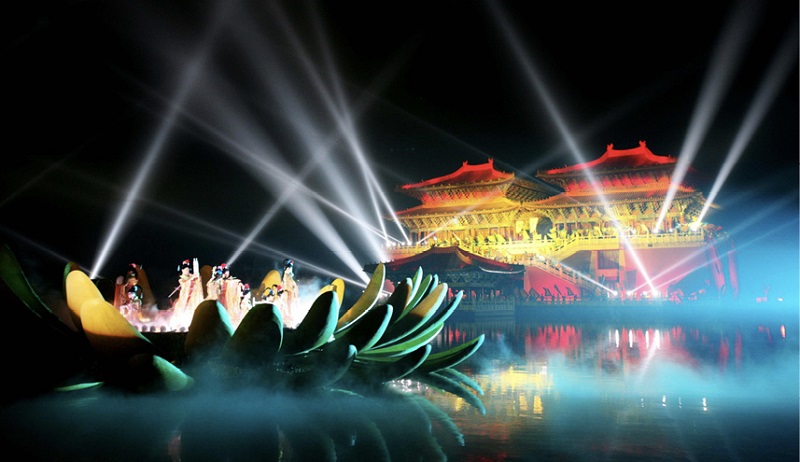The Millennium City Park has boosted the recovery of consumption by injecting new life into historical resources and promoting cultural tourism.

An aerial view of the large historical and cultural theme park the Millennium City Park that has restored the ancient sites of the Northern Song Dynasty.
China's domestic tourism market has maintained strong recovery since last year. One highlight of this positive recovery is the Millennium City Park which made milestone achievements in its operations during the Spring Festival holiday from February 10 to 17, 2024.
Wang Shuang, a deputy to the National People’s Congress (NPC) and the park’s president, said that the number of tourist arrivals during this year’s Spring Festival holiday exceeded 700,000, a year-on-year increase of over 65 percent. Earnings exceeded RMB 100 million, up 60 percent from the previous year.
Wang is fully confident of the potential for consumption recovery in cultural tourism. “The two sets of data show that the theme park as a whole is seeing a stable and positive trend,” she told China Today.

A series of large-scale performances is held every day in the Millennium City Park.
Stimulating Historical Resources
The Millennium City Park is located in the city of Kaifeng in central China’s Henan Province. The city served as capital of several feudal dynasties in ancient China. Inspired by the famous traditional Chinese painting Qingming Festival at the Riverside, it is a large historical and cultural theme park that has restored the ancient sites of the Northern Song Dynasty (960-1127).
Since its opening in October 1998, the theme park has utilized various innovative ways to preserve Song culture by bringing historical sites back to life, so as to promote the deep integration of culture and tourism.
Within an area of more than 30,000 square meters, there are restored architectures that are replicas of those depicted in the painting. All staff workers wear Song makeups and costumes, offering visitors an immersive experience of the ancient Song Dynasty.
In addition to the magnificent architectural complex and distinctive cultural experience, a series of plays are performed in the park every day to help tourists get a better understanding of ancient Chinese history. From small shows with one or two performers to a series of large-scale plays, over 100 performances are scheduled during the daytime on weekdays, and the figure can reach 200 during holidays.
In accordance with the changing demands and popular interests in the cultural tourism industry, the park also updates the performance repertoire every year. The annual update rate is 20 percent. “For some popular plays, we add new content to improve the quality and adapt to the needs of tourists, especially for young people,” Wang told China Today.
New technologies are also employed to create more innovative performances. The park management has created several kinds of digital products like the 5D dome show. These changes have helped promote the updating of tourism products to maintain a high level of competitiveness as well as the integrated development of cultural, tourism, and creative products.
Amid efforts to meet the popular market demands and diverse needs of tourists, the park launched a series of festive activities during the Spring Festival holiday in February 2024, which included a custom festival and a lantern exhibition. During the holiday, over 200 shows of different sizes were held in the park every day, and the number of live-action nighttime acrobatics shows was also increased to four every day.
At the same time, the third phase of the amusement area in the park has been opened to the public. This area consists of innovate infrastructures integrating culture and technology like Asia’s largest carousel. The last part of the park will be an area full of hotels and accommodations of Song style. It will be finished this year.
“We have explored the vitality of history with performing arts, and the China-chic style is becoming increasingly recognized by the public. It is not only a trend now, but also a part of people’s real life,” Wang said.

A stage view of the live-action nighttime acrobatics show Kaifeng Menghua. Photos courtesy of the Millennium City Park
Restructuring the Industry
China has always attached great importance to the development of tourism. In September 2023, to better meet people’s needs for a better life and promote economic and social development, the State Council issued several measures to help release the potential of tourism consumption and promote the high-quality development of tourism.
In the 2024 government work report, China pledged to foster new engines for consumption growth, such as smart home appliances, entertainment, tourism, sports events, and domestic brands with Chinese design elements.
According to the Ministry of Culture and Tourism, during the year 2023, China’s domestic tourism market saw nearly 4.9 billion trips, a year-on-year increase of 93.3 percent. Total tourism spendings reached RMB 4.91 trillion in 2023, a striking increase of 140.3 percent year-on-year. During the Spring Festival holiday, the domestic tourism market saw 474 million trips and nearly 2.3 billion cross-provincial trips were made.
Many regions in China have also launched new cultural tourism projects, preferential promotion policies, and innovative consumption scenarios. Henan Province is rich in cultural tourism resources. The provincial government has elevated the integration of culture, tourism, and innovation to one of its 10 development strategies. Governments at all levels in the province have also issued various policies to provide opportunities for the integrated development of cultural tourism.
Wang said that the series of policies issued by the governments has supported and guaranteed the positive development of the cultural tourism industry. The industry should make full use of these favorable policies to obtain funding, tax incentives, and other financial support. At the same time, it should also continue to promote traditional Chinese culture and provide innovative products and services, so as to enable more people to learn about the unique charm of traditional Chinese culture.
At the moment, the cultural tourism industry in China is still facing several challenges. Wang said that under the current intensely competitive environment, it should take a diversified development path by creating innovative products. Each locality needs to create high-quality products and services to attract more tourists.
Meanwhile, as technologies, such as virtual reality, and augmented reality, are applied to tourism products, it has changed tourists’ traveling experience. According to the guidelines stated in the 2024 government work report and the 14th five-year plan for cultural tourism, all tourists stops must promote the application of information technology and intelligent technology, and further accelerate the digital transformation of scenic spots, said Wang.
In China’s cultural tourism industry, small and medium-sized private enterprises account for a large proportion. “For an industry to develop well, it cannot just rely on leading enterprises. It should also leverage small and medium-sized enterprises in order to achieve a healthy and sustainable development of the entire industry,” Wang said.
Wang visited many small and medium-sized private enterprises when performing her duties as an NPC deputy to better familiarize herself with the problems they face in their daily business. At this year’s “Two Sessions,” she submitted a proposal about reducing taxes and fees and strengthening financial support for the industry. She hopes by issuing more targeted policies, the government can provide a more favorable environment for the stable and healthy development of small and medium-sized enterprises in the cultural tourism sector.